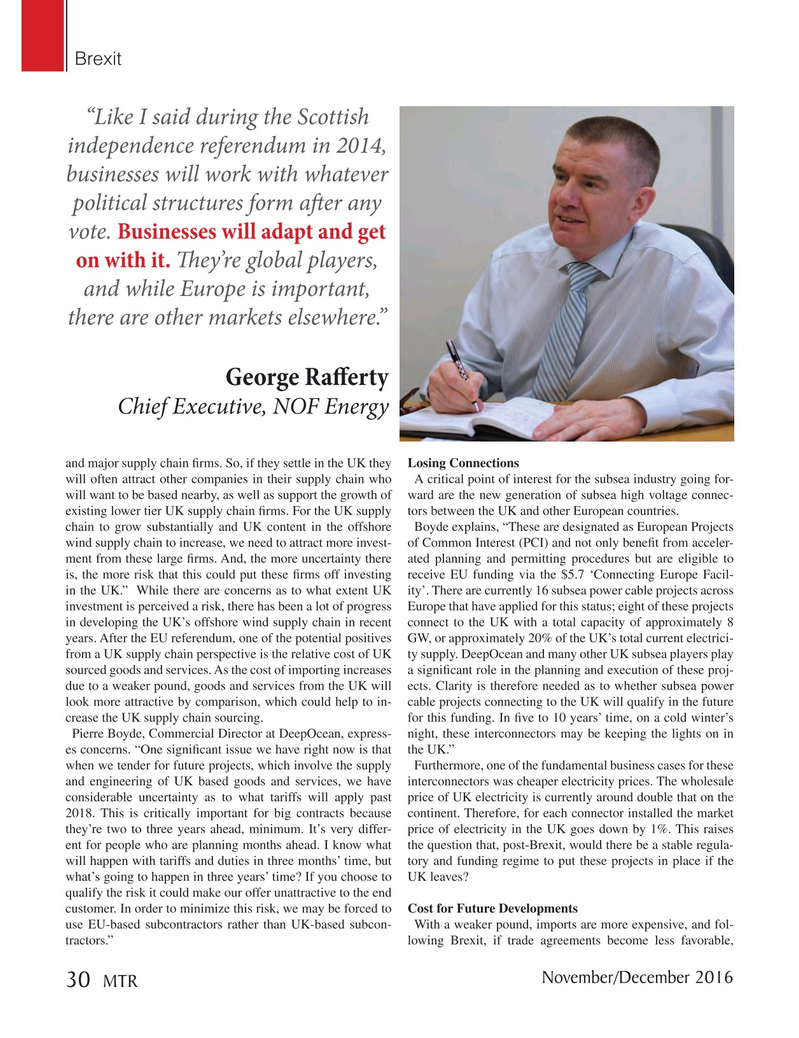
Page 30: of Marine Technology Magazine (November 2016)
Subsea Engineering & Construction
Read this page in Pdf, Flash or Html5 edition of November 2016 Marine Technology Magazine
Brexit “Like I said during the Scottish independence referendum in 2014, businesses will work with whatever political structures form af er any vote. Businesses will adapt and get on with it. T ey’re global players, and while Europe is important, there are other markets elsewhere.”
George Raf erty
Chief Executive, NOF Energy and major supply chain ? rms. So, if they settle in the UK they Losing Connections will often attract other companies in their supply chain who A critical point of interest for the subsea industry going for- will want to be based nearby, as well as support the growth of ward are the new generation of subsea high voltage connec- existing lower tier UK supply chain ? rms. For the UK supply tors between the UK and other European countries. chain to grow substantially and UK content in the offshore Boyde explains, “These are designated as European Projects wind supply chain to increase, we need to attract more invest- of Common Interest (PCI) and not only bene? t from acceler- ment from these large ? rms. And, the more uncertainty there ated planning and permitting procedures but are eligible to is, the more risk that this could put these ? rms off investing receive EU funding via the $5.7 ‘Connecting Europe Facil- in the UK.” While there are concerns as to what extent UK ity’. There are currently 16 subsea power cable projects across investment is perceived a risk, there has been a lot of progress Europe that have applied for this status; eight of these projects in developing the UK’s offshore wind supply chain in recent connect to the UK with a total capacity of approximately 8 years. After the EU referendum, one of the potential positives GW, or approximately 20% of the UK’s total current electrici- from a UK supply chain perspective is the relative cost of UK ty supply. DeepOcean and many other UK subsea players play sourced goods and services. As the cost of importing increases a signi? cant role in the planning and execution of these proj- due to a weaker pound, goods and services from the UK will ects. Clarity is therefore needed as to whether subsea power look more attractive by comparison, which could help to in- cable projects connecting to the UK will qualify in the future crease the UK supply chain sourcing. for this funding. In ? ve to 10 years’ time, on a cold winter’s
Pierre Boyde, Commercial Director at DeepOcean, express- night, these interconnectors may be keeping the lights on in es concerns. “One signi? cant issue we have right now is that the UK.” when we tender for future projects, which involve the supply Furthermore, one of the fundamental business cases for these and engineering of UK based goods and services, we have interconnectors was cheaper electricity prices. The wholesale considerable uncertainty as to what tariffs will apply past price of UK electricity is currently around double that on the 2018. This is critically important for big contracts because continent. Therefore, for each connector installed the market they’re two to three years ahead, minimum. It’s very differ- price of electricity in the UK goes down by 1%. This raises ent for people who are planning months ahead. I know what the question that, post-Brexit, would there be a stable regula- will happen with tariffs and duties in three months’ time, but tory and funding regime to put these projects in place if the what’s going to happen in three years’ time? If you choose to UK leaves? qualify the risk it could make our offer unattractive to the end customer. In order to minimize this risk, we may be forced to Cost for Future Developments use EU-based subcontractors rather than UK-based subcon- With a weaker pound, imports are more expensive, and fol- tractors.” lowing Brexit, if trade agreements become less favorable,
November/December 2016
MTR 30
MTR #9 (18-33).indd 30 MTR #9 (18-33).indd 30 12/7/2016 2:57:36 PM12/7/2016 2:57:36 PM

 29
29

 31
31
